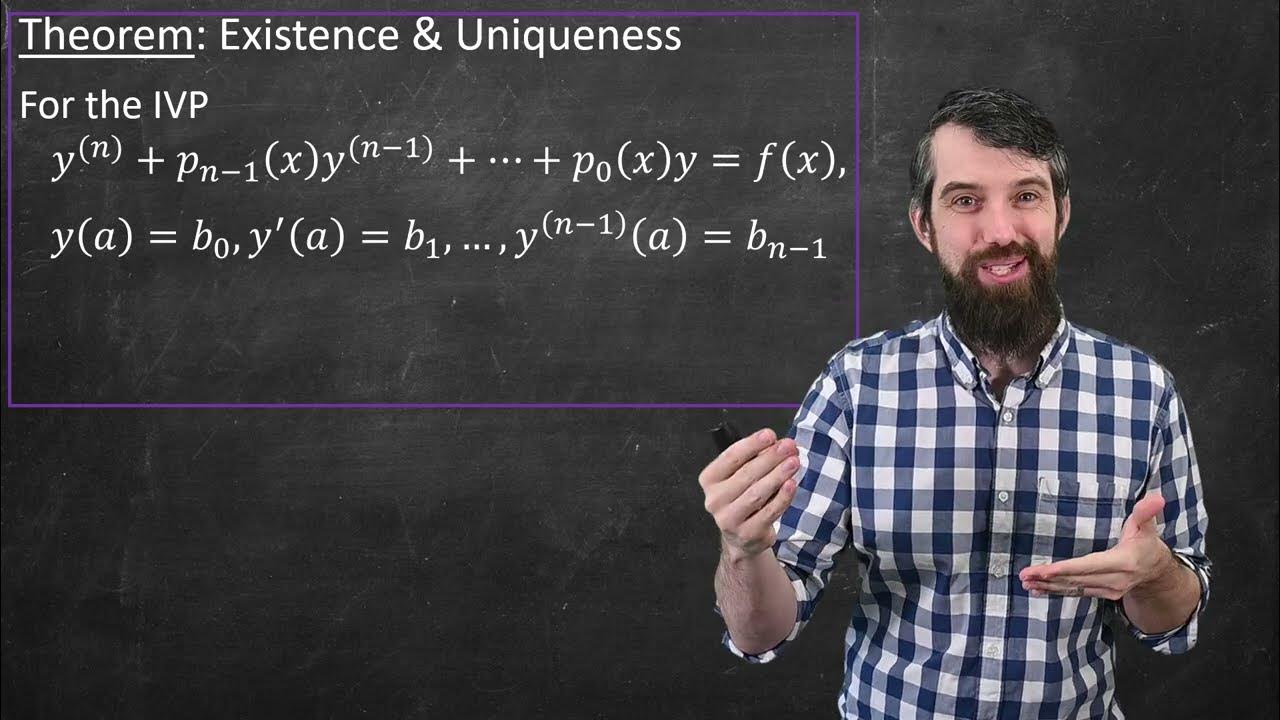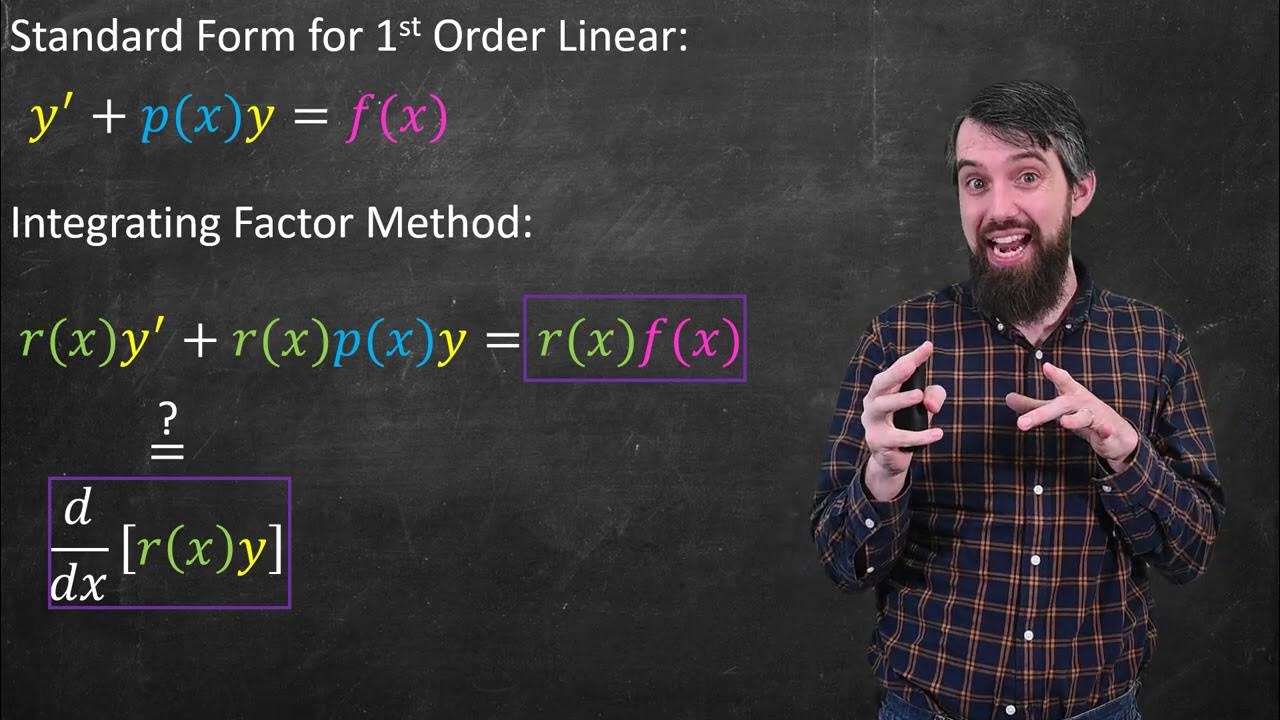8.8 ODE Lab Exercises
TLDRThis video script delves into solving differential equations using the leapfrog method, focusing on practical application. It emphasizes the importance of selecting the optimal step size 'h' and algorithm effectiveness. The script uses harmonic oscillators as a basis, comparing analytical and numerical solutions for validation. It introduces energy conservation as a metric for solution accuracy, recommending plotting energy components over time to ensure constancy. The lecture encourages exploring various 'p' values in potential functions to understand non-linear oscillators' behavior, highlighting the virial theorem's relevance. It concludes with a directive for hands-on lab work to achieve high precision in solving linear and non-linear oscillators.
Takeaways
- 📚 The script discusses solving differential equations using numerical methods, specifically the leapfrog method.
- 🔍 It emphasizes the importance of choosing the right value for 'h' and the best algorithm for solving these equations in a practical scenario.
- 🤔 The script poses questions about what makes an algorithm good or bad and how to determine the best value for 'h'.
- 🎭 It uses the example of oscillators, particularly harmonic oscillators, to illustrate the concept of periodic motion and the application of the leapfrog method.
- 📉 The script explains that for a harmonic oscillator, the motion is sinusoidal and can be represented by a function involving amplitude, angular frequency, and phase.
- 🔑 The known analytical solution for a harmonic oscillator is given by a sinusoidal function, which is used to validate the numerical method.
- 🛠️ The script provides guidelines for setting up the problem, including using double precision and choosing values for k and m to simplify calculations.
- 📈 It suggests starting with a small value for 'h' and gradually decreasing it to observe the improvement in the solution until round-off errors become significant.
- 📊 The importance of qualitative analysis is highlighted, where the solution's smoothness and periodicity are checked before quantitative analysis.
- 🌐 Energy conservation is presented as a key metric for assessing the accuracy of the numerical solution, with the script explaining how to plot and analyze energy components over time.
- 📝 The script instructs students to solve for simple harmonic motion, vary 'h' values to achieve high precision, and compare different numerical methods like Euler's method, Runge-Kutta, and optionally, RK45.
- 🔬 As an optional exploration, the script encourages examining non-linear oscillators, varying initial conditions, and understanding the effects on motion and period.
Q & A
What is the leapfrog method mentioned in the script?
-The leapfrog method is a numerical algorithm used for solving differential equations, particularly those that describe the motion of particles in a potential field. It is an explicit method for solving second-order ordinary differential equations and is known for its stability and simplicity.
Why is it important to choose a good value for 'h' in numerical algorithms?
-The value of 'h' represents the step size in numerical methods. Choosing an appropriate value for 'h' is crucial because it affects the accuracy and stability of the solution. If 'h' is too large, the algorithm may not accurately capture the behavior of the system, while if it's too small, the computation may become inefficient due to excessive computational cost.
What is the significance of using oscillators in the context of this script?
-Oscillators, particularly harmonic oscillators, are used to demonstrate the application of numerical methods in solving differential equations. They provide a good test case because the motion of an oscillator is periodic, and if there is no friction, the motion should repeat itself indefinitely, allowing for the verification of the algorithm's accuracy against known periodic behavior.
What does the script mean by 'the motion must be periodic'?
-In the context of the script, 'periodic motion' refers to the behavior of a system that repeats itself over time. For example, in a harmonic oscillator, the position of the oscillator as a function of time will follow a sinusoidal pattern that repeats at regular intervals, which is a characteristic of periodic motion.
Why is the harmonic oscillator a good starting point for learning numerical methods?
-The harmonic oscillator is a good starting point because its motion can be described analytically, providing an exact solution for comparison with the numerical solution. This allows learners to verify the accuracy of their numerical methods and understand how well the algorithm performs in reproducing known solutions.
What is the role of energy conservation in evaluating the accuracy of a numerical solution?
-Energy conservation serves as an important check for the accuracy of a numerical solution. If the system being modeled has no external forces or friction, the total mechanical energy (kinetic plus potential) should remain constant. By monitoring the conservation of energy in the numerical solution, one can assess the precision and reliability of the algorithm.
How can the relative error in energy be used to evaluate the precision of a numerical solution?
-The relative error in energy is calculated by comparing the total energy at a given time with the initial energy. By taking the logarithm of the relative error, one can estimate the number of decimal places of precision in the solution. A smaller relative error indicates higher precision, which is desirable in numerical solutions.
What is the purpose of plotting potential, kinetic, and total energy over time in the context of this script?
-Plotting these energies over time allows one to visually inspect the conservation of energy in the system. If the total energy (kinetic plus potential) remains constant over time, it indicates that the numerical solution is conserving energy as expected in a closed system without external influences.
Why is it suggested to start with a small 'h' value and then make it smaller until the solution gets better?
-Starting with a small 'h' value allows one to see if the solution improves as 'h' decreases, which is an indication that the algorithm is converging to the correct solution. However, if 'h' becomes too small, round-off errors may start to dominate, and the solution may deteriorate, indicating the limits of the algorithm's precision.
What is the virial theorem mentioned in the script, and how does it relate to non-linear oscillators?
-The virial theorem is a statement in dynamics that relates the average kinetic and potential energies over a complete cycle of motion. For non-linear oscillators, it suggests that as the power 'p' increases, the system spends more time near the turning points with low kinetic energy and less time in the middle of the oscillation with high kinetic energy, leading to a different shape of motion compared to harmonic oscillators.
Outlines
🔬 Introduction to Solving Differential Equations with Leapfrog Method
The script begins with an introduction to solving differential equations using the leapfrog method. It emphasizes the importance of selecting an appropriate value for 'h' and the best algorithm for the task. The discussion centers around the use of oscillators, particularly harmonic oscillators, as they exhibit periodic motion. The script introduces the concept of potential and kinetic energy and their relationship in a harmonic oscillator. It also explains the significance of knowing the analytical solution to validate the computer's numerical solution, especially when no analytical solution exists for other values of 'p'. The known answer for a harmonic oscillator is a sinusoidal function of time, which is periodic and can be represented by an amplitude times a sine or cosine function, with a phase shift.
📚 Practical Considerations for Numerical Solutions and Energy Conservation
This paragraph delves into the practical aspects of using numerical methods to solve differential equations. It discusses the importance of using double precision in calculations to avoid errors and suggests choosing values for 'k' and 'm' to simplify the period 't' to a manageable constant. The script advises starting with a small step size 'h' and gradually reducing it to observe the convergence of the solution. It also highlights the qualitative assessment of the solution's smoothness and periodicity, as well as the importance of energy conservation as a test for the accuracy of the numerical solution. The paragraph concludes with the recommendation to plot potential, kinetic, and total energy over time to ensure that the energy remains constant, indicating a correct solution.
📉 Analyzing Algorithm Precision with Energy Conservation Metrics
The focus shifts to the quantitative analysis of algorithm precision using energy conservation as a metric. The script instructs on plotting potential and kinetic energy over time and observing their correlation to ensure energy conservation. It introduces a method to calculate the relative error in energy and suggests using the logarithm of this error to determine the number of decimal places of precision in the solution. The paragraph provides an example of a student's graph that demonstrates the oscillation of relative error over time, indicating the presence of error cancellations and the potential for high precision in the solution.
📝 Laboratory Assignment: Solving Simple Harmonic Motion and Algorithm Comparison
The script outlines a laboratory assignment where students are tasked with solving simple harmonic motion using different numerical methods, such as Euler's method, Runge-Kutta methods (RK2, RK4, and optionally RK45), and comparing their precision and computational efficiency. Students are encouraged to adjust the step size 'h' to achieve at least 11 decimal places of precision and observe the impact of smaller step sizes on precision and computational cost. The assignment also includes comparing linear and non-linear oscillators and understanding the effects of changing the power 'p' and initial conditions on the motion of the oscillator.
🔍 Exploring Non-Linear Oscillators and the Virial Theorem
The final paragraph reviews the exploration of non-linear oscillators, where students are asked to vary the power 'p' and initial conditions to observe the effects on the oscillator's motion. It discusses the constancy of the period 't' and amplitude in non-linear oscillations and how changes in initial conditions can lead to different motion shapes. The script introduces the concept of the Virial theorem, which relates the average kinetic and potential energy over time, and suggests that as 'p' increases, the particle spends most of its time nearly free in the middle of the well, with large kinetic energy only when bouncing off the edges. Students are encouraged to use computational tools to learn and understand these phenomena.
Mindmap
Keywords
💡Differential Equations
💡Leapfrog Method
💡Harmonic Oscillator
💡Periodic Motion
💡Algorithm
💡Precision
💡Energy Conservation
💡Runge-Kutta Methods
💡Non-Harmonic Oscillator
💡Initial Conditions
💡Virial Theorem
Highlights
Introduction to solving differential equations using the leapfrog method.
The importance of selecting the best value of 'h' and choosing the best algorithm for solving differential equations.
Understanding the periodic and harmonic motion of oscillators in the context of differential equations.
The significance of the harmonic oscillator and its analytical solution for validating computational methods.
The relationship between the natural frequency (omega 0) and the period of motion in oscillators.
General rules of thumb for computational solutions, including the use of double precision and careful selection of constants.
The qualitative assessment of computational solutions through smoothness and periodicity of the motion.
Quantitative analysis using energy conservation as a metric for the precision of the solution.
The concept of isochronous motion and its relevance to harmonic motion.
The use of logarithms to measure the relative error and determine the precision of computational solutions.
Comparing different numerical methods like Euler, Runge-Kutta, and their performance in terms of precision and computational cost.
The practical steps to start with an algorithm, beginning with a small 'h' value and gradually refining it.
The impact of initial conditions on the period and shape of non-linear oscillators' motion.
The Virial Theorem and its application in understanding the behavior of particles in non-linear oscillators.
The detailed analysis of non-linear oscillators and the variation of motion with different powers of 'p'.
The importance of changing 'h' values based on the power 'p' and initial conditions for accurate simulations.
Encouragement for learners to apply computational methods to explore new concepts and enhance their understanding of dynamics.
Transcripts
Browse More Related Video

The Theory of Higher Order Differential Equations

Linear Differential Equations & the Method of Integrating Factors

2021 Live Review 4 | AP Physics C: Mechanics | Everything You Need to Know about Nonlinear Springs

ILLUSTRATING THE SYSTEM OF NONLINEAR EQUATIONS || PRECALCULUS

1. Periodic Oscillations, Harmonic Oscillators

Lagrangian Mechanics II: Degrees of freedom, generalized coordinates and a cylinder
5.0 / 5 (0 votes)
Thanks for rating: